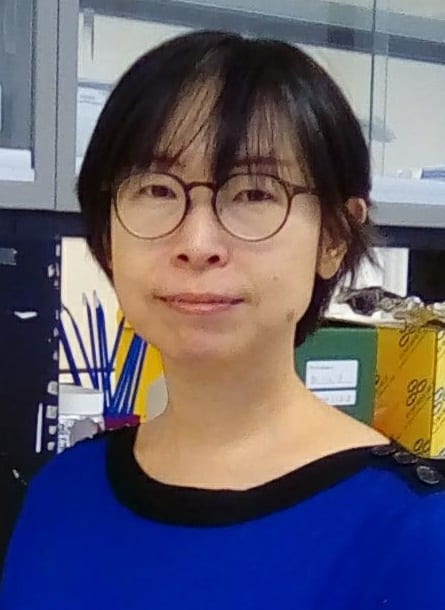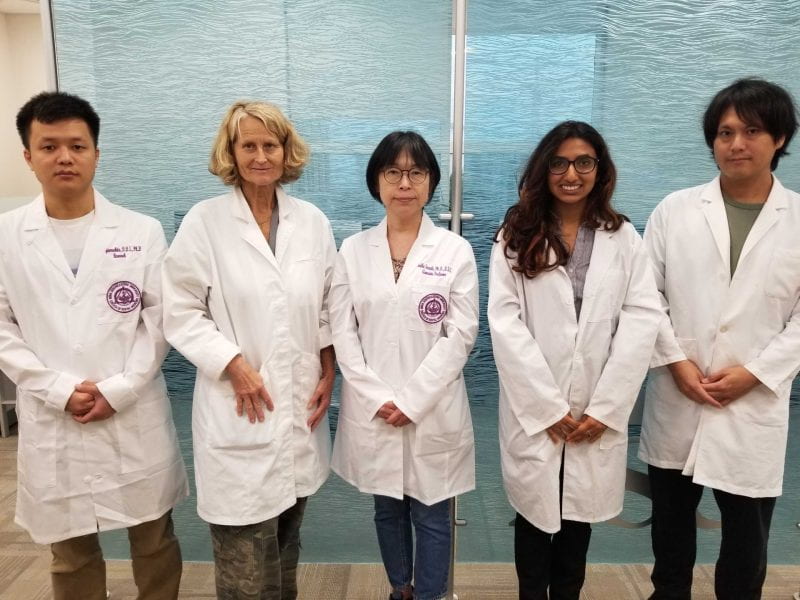Spotlight on a Researcher – Maiko Suzuki, PhD (Dental Medicine)


Maiko Suzuki, D.D.S., Ph.D., is an Associate Professor in the Department of Oral Science and Translational Research at the College of Dental Medicine. Dr. Suzuki earned her Doctor of Dental Surgery (D.D.S.) and Doctor of Philosophy in Dentistry (Ph.D.) from Tohoku University in Japan. Before joining NSU, Dr. Suzuki was an Assistant Research Investigator at the Forsyth Institute, an Assistant Professor at Tohoku University, the Ohio State University, and the Dental College of Georgia, and an Associate Professor at Augusta University.
Dr. Suzuki’s overarching objective in the dental-oral-craniofacial field is to identify environmental factors related to craniofacial pathophysiology and develop novel preventive and therapeutic strategies for environmental factor-associated oral diseases.
Tell me briefly about your current grant-funded projects.
To achieve my overarching objectives, I have been working on two NIH grant-funded projects. One is the R01 project, entitled “Epigenetic and non-epigenetic role of SIRT1 in fluoride-induced cell stress” (NIDCR R01DE027648), and another is the K02 Independent Investigator Career Development grant, titled “Health Effects of the Fluorinated Pollutants; PFAS on Enamel Development” (NIDCR K02DE029531).
R01 project (Fluoride): As you know, fluoride is widely accepted as an effective caries prophylactic. However, chronic over-exposure can result in adverse health effects, including dental and skeletal fluorosis. We aim to develop novel strategies that prevent or reduce dental fluorosis (tooth enamel malformation) while keeping the benefit of prophylactic fluoridation to prevent caries. The R01 project focuses on SIRT1 protective function against fluoride-mediated tooth malformation. It is known that SIRT1 (Class III histone deacetylase) deacetylates histones to repress gene expression (epigenetic deacetylation). In contrast, SIRT1 deacetylates several non-histone proteins (non-epigenetic deacetylation) functioning to adapt to cell stress and regulate cell survival and organismal lifespan. Based on our previous findings that SIRT1 could protect ameloblasts (cells responsible for enamel formation) from fluoride-mediated cell stress in vitro, the R01 project is awarded. We have been investigating the protective functions and molecular mechanisms of SIRT1 in rodent dental fluorosis models using SIRT1 conditional knockout mice and SIRT1 overexpressing mice. Our results could contribute to novel strategies targeting SIRT1 functions to prevent or alleviate dental fluorosis.
K02 project (Organofluorine, PFAS): To widen the scope of my research and broaden my academic range to include in environmental health sciences, I am to expand the fluoride research project to characterize the health effects of organofluorine, PFAS (per- and poly-fluoroalkyl substances) on tooth development. PFAS are a large group of artificial fluorinated organic compounds that have generated increased public attention due to their ubiquitous presence in the environment (oceans, groundwater, drinking water, food, etc.) and potential health hazards. PFAS exposure can affect reproduction, development, and cancer incidents. Environmental factors (e.g., fluoride) can cause enamel hypoplasia during tooth formation. However, the effects of PFAS on ameloblasts and tooth enamel formation remain largely unknown. Our study demonstrated that PFAS could cause adverse effects on tooth formation in vitro. In the K02 project, we have investigated the molecular mechanisms of how PFAS affects tooth formation in rodent models in vivo. This project will provide new insights that PFAS could be considered as a possible causative factor for cryptogenic abnormalities in amelogenesis, e.g., Molar Incisor Hypomineralization (MIH), of which the etiologies are not fully understood.
Who is working with you on these projects?
My laboratory is in the Center for Collaborative Research (CCR) at NSU. I am working with my lab members: two Postdoctoral Researchers, Dr. Shohei Yamashita (D.D.S., Ph.D.) and Dr. Motoki Okamoto (D.D.S., Ph.D.), and a Research Assistant, Dr. Susanne Brueckner (Ph.D.), and an undergraduate student, Ms. Melanie Mendonca (College of Psychology, NSU), supported by the NIH undergraduate research training initiative for student enhancement (U-RISE, T34) program. In addition to my lab members, Dr. Alireza Heidari (Assistant Professor, Ph.D., Dpt. Oral Science and Translational Research, CDM, NSU) supports micro-CT analysis, and Dr. Robert P Smith (Associate Professor, Ph.D., Dpt. Medical Education, Kiran Patel College of Allopathic Medicine) helps us with microbiome analysis. External collaborators are Dr. Eric T. Everett (Professor, Ph.D., UNC Chapel Hill), who is an expert on fluoride toxicity in tooth development and he analyzes Quantitative Light-induced Fluorescence (QLF) to evaluate enamel fluorosis; Dr. John D. Bartlett (Professor, Ph.D., Ohio State University), who provides insights about the pathophysiology of enamel development; Dr. Marion A. Cooley (Assistant Professor, Ph.D., Augusta University), who assists bone analysis; and Dr. Marilia Afonso Rabelo Buzalaf (Professor, D.D.S., Ph.D., University of São Paulo), who has expertise in systemic fluoride toxicology and supports proteomic analysis.

Lab members from left to right: Dr. Shohei Yamashita, Dr. Susanne Brueckner, Dr. Maiko Suzuki, Ms. Melanie Mendonca, Dr. Motoki Okamoto.
What opportunities and/or benefits do these grants bring to the NSU community?
Both R01 and K02 projects focus on the adverse health effects of fluorinated environmental pollutants (fluoride and PFAS) on tooth enamel formation. We investigate the molecular mechanisms of SIRT1 functions to protect ameloblasts against fluoride toxicity in R01 and PFAS-mediated dental oral craniofacial pathophysiology in K02. The results of these studies could lead to a paradigm shift for the clinical treatment of enamel malformation modulating SIRT1 or PFAS exposures. Under these two projects, I foster the next generation of scientists. Currently, two postdocs, a Ph.D. student (University of São Paulo) and an undergraduate student (NSU) are participating in our projects to gain expertise in environmental toxicology in the dental-oral-craniofacial field.
How do these projects connect with your other work at NSU?
Since I completed my D.D.S. and Ph.D. at Tohoku University in Japan, I have had research experiences in several fields studying the molecular biology of oral cancer, periodontitis, enamel development, and enamel hypoplasia, including dental fluorosis. In addition to adverse effects on tooth enamel malformation, PFAS can cause other systemic health issues, especially as a potential risk factor for cancer. Some studies demonstrated that PFAS can increase some types of cancer risks, including testicular, prostate, breast, and kidney cancers. However, the biological effects of PFAS on oral cancer incidence and metastasis have not been identified. Based on my expertise in oral cancer research, collaborating with Dr. Xiaozhe Han (Professor, D.D.S., Ph.D., Dpt. Oral Science and Translational Research, CDM, NSU) and Dr. Natalia Soares Quinete (Assistant Professor, Ph.D., Florida International University), I plan to expand the current PFAS project into oral cancer research to investigate the PFAS biological effects on oral cancer bone metastasis.
I am also interested in the effects of PFAS on microbiota. PFAS are artificial forever chemicals with the strongest carbon-fluorine (C-F) bonds that are difficult to degrade. However, PFAS can be partially metabolized by some bacteria. Details of the bacterial species and the mechanisms of this metabolic process remain unexplained. Collaborating with Dr. Smith (MD, NSU), we have investigated how PFAS alters bacterial Flora in the digestive system in mice. Based on the results, I will develop a new research project to study the effects of PFAS on oral and gut microbiota.
How has NSU helped you pursue and/or achieve personal and professional goals you have set for yourself? NSU resources used?
I am grateful for the support from the College of Dental Medicine (CDM), Dr. Steven Kaltman (CDM Dean and Professor, D.M.D., M.D., FACS), and the Department Chair of Oral Science and Translational Research Dr. Toshihisa Kawai (Professor, D.D.S., Ph.D.), and department researchers and staff. The CDM provides me with protective time to focus on research and the resources necessary to conduct R01 and K02 projects. The research environment, scientific network, and Core Facilities at CCR and CDM are excellent. Also, I appreciate the Office of Sponsored Programs (OSP) within the Division of Research and Economic Development (DoR) to transfer my grants and submit new grant applications.
What advice do you have for other grant seekers at NSU?
To develop grantsmanship, I recommend joining the grant writing workshops, seminars, and training. For example, the NSU Grant Writing Lab (DoR) offers a mentoring program, and the NIH Office of External Research (OER) provides resources for grants and funding information. It is crucial to keep your eyes open for funding opportunities that suit your research fields by receiving “Funding Alert” emails from DoR.
What is the next grant proposal or project on your agenda?
I am preparing for submission of a competing renewal of the R01. To develop my NIH K02 PFAS project, I recently applied for an external grant to study PFAS effects on oral cancer in collaboration with Dr. Han (CDM, NSU) and Dr. Quinete (FIU). Based on preliminary results from the K02 project with Dr. Smith (MD, NSU), I plan to launch a new research project to study the effects of PFAS on oral and gut microbiota.